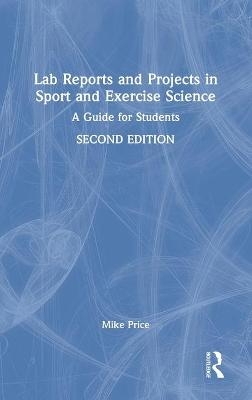
Lab Reports and Projects in Sport and Exercise Science
A Guide for Students
Seiten
2021
|
2nd edition
Routledge (Verlag)
978-0-367-63182-6 (ISBN)
Routledge (Verlag)
978-0-367-63182-6 (ISBN)
This revised edition sees the expansion of statistical examples including data checks, critical appraisal tools, project planning and ‘Challenge yourself’ activities to supplement understanding. It guides the reader through abstracts, literature reviews, methodology, reporting discussions and referencing, and how to improve your writing.
Most science degrees will have a practical or laboratory-based component which will require some sort of final report, whether this be a conventional laboratory report or a final-year dissertation. All of these formats require students to be able to analyse their data in an appropriate way and subsequently convey their key thoughts and information to a third party. Therefore, writing laboratory reports is an essential part any science degree.
This new revised edition sees the expansion of statistical examples including initial data checks and assumptions, increased awareness of critical appraisal tools and resources, project planning and a range of 'Challenge yourself' activities to supplement understanding and provides a comprehensive overview of what should be contained within each section of a scientific report, and clearly explains how it should be presented. Written in a friendly and engaging style, it guides the reader through abstracts, literature reviews, methodology, reporting discussions and referencing and contains a wealth of examples and practical advice on how to improve and refine your own writing. From writing a first lab report to preparing a final-year dissertation or postgraduate thesis, sports and exercise science students at all levels will find this book a valuable resource in developing both skill and confidence in scientific communication. Key features include:
The layout of the book is designed to reflect that of a typical scientific report to help students plan their own projects.
Each chapter includes numerous examples, exercises and activities to engage students and develop skills in each aspect of report writing.
The book includes discussion of critical appraisal techniques to help students refine their research questions.
All data sets and illustrations used are drawn from the key disciplines in sport and exercise science, including physiology, psychology and biomechanics.
Most science degrees will have a practical or laboratory-based component which will require some sort of final report, whether this be a conventional laboratory report or a final-year dissertation. All of these formats require students to be able to analyse their data in an appropriate way and subsequently convey their key thoughts and information to a third party. Therefore, writing laboratory reports is an essential part any science degree.
This new revised edition sees the expansion of statistical examples including initial data checks and assumptions, increased awareness of critical appraisal tools and resources, project planning and a range of 'Challenge yourself' activities to supplement understanding and provides a comprehensive overview of what should be contained within each section of a scientific report, and clearly explains how it should be presented. Written in a friendly and engaging style, it guides the reader through abstracts, literature reviews, methodology, reporting discussions and referencing and contains a wealth of examples and practical advice on how to improve and refine your own writing. From writing a first lab report to preparing a final-year dissertation or postgraduate thesis, sports and exercise science students at all levels will find this book a valuable resource in developing both skill and confidence in scientific communication. Key features include:
The layout of the book is designed to reflect that of a typical scientific report to help students plan their own projects.
Each chapter includes numerous examples, exercises and activities to engage students and develop skills in each aspect of report writing.
The book includes discussion of critical appraisal techniques to help students refine their research questions.
All data sets and illustrations used are drawn from the key disciplines in sport and exercise science, including physiology, psychology and biomechanics.
Mike Price, PhD is a Reader in Exercise Physiology at Coventry University. He has taught exercise physiology and research methods at undergraduate and postgraduate levels for over 20 years and supervised numerous postgraduate research students. He acts as an external examiner for taught courses and PhD examinations and reviews for many key journals within sport and exercise science.
Introduction
1. Abstracts
2. Introductions and Literature Reviews
3. Methods
4. Results
5. Discussion
6. Planning, Referencing and General Writing Tips
Appendices
References
Index
| Erscheinungsdatum | 04.01.2022 |
|---|---|
| Zusatzinfo | 49 Tables, black and white; 28 Line drawings, black and white; 28 Illustrations, black and white |
| Verlagsort | London |
| Sprache | englisch |
| Maße | 156 x 234 mm |
| Gewicht | 630 g |
| Themenwelt | Sachbuch/Ratgeber ► Sport |
| Sozialwissenschaften ► Pädagogik ► Schulpädagogik / Sekundarstufe I+II | |
| Weitere Fachgebiete ► Sportwissenschaft | |
| ISBN-10 | 0-367-63182-2 / 0367631822 |
| ISBN-13 | 978-0-367-63182-6 / 9780367631826 |
| Zustand | Neuware |
| Informationen gemäß Produktsicherheitsverordnung (GPSR) | |
| Haben Sie eine Frage zum Produkt? |
Mehr entdecken
aus dem Bereich
aus dem Bereich
Praxisbuch Meyer
Buch | Softcover (2021)
Cornelsen (Verlag)
CHF 33,90


